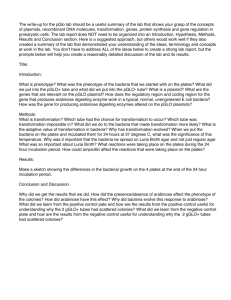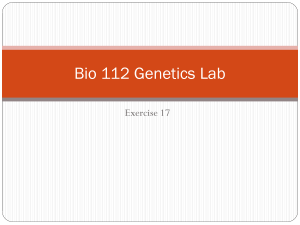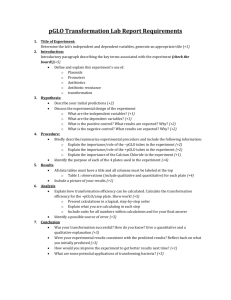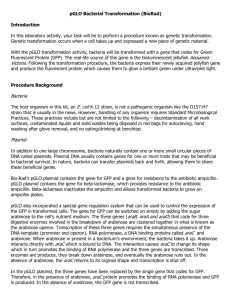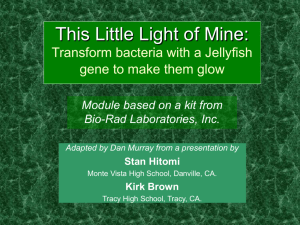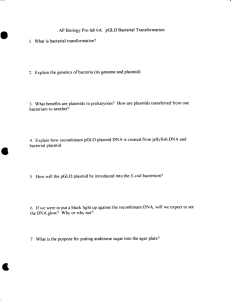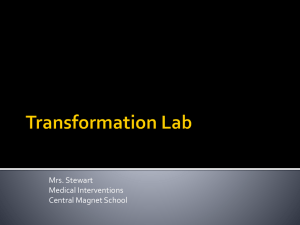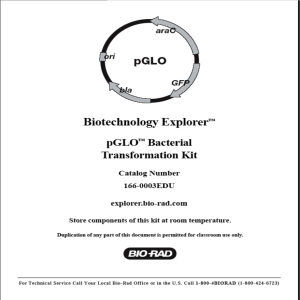Bacterial Transformation
advertisement
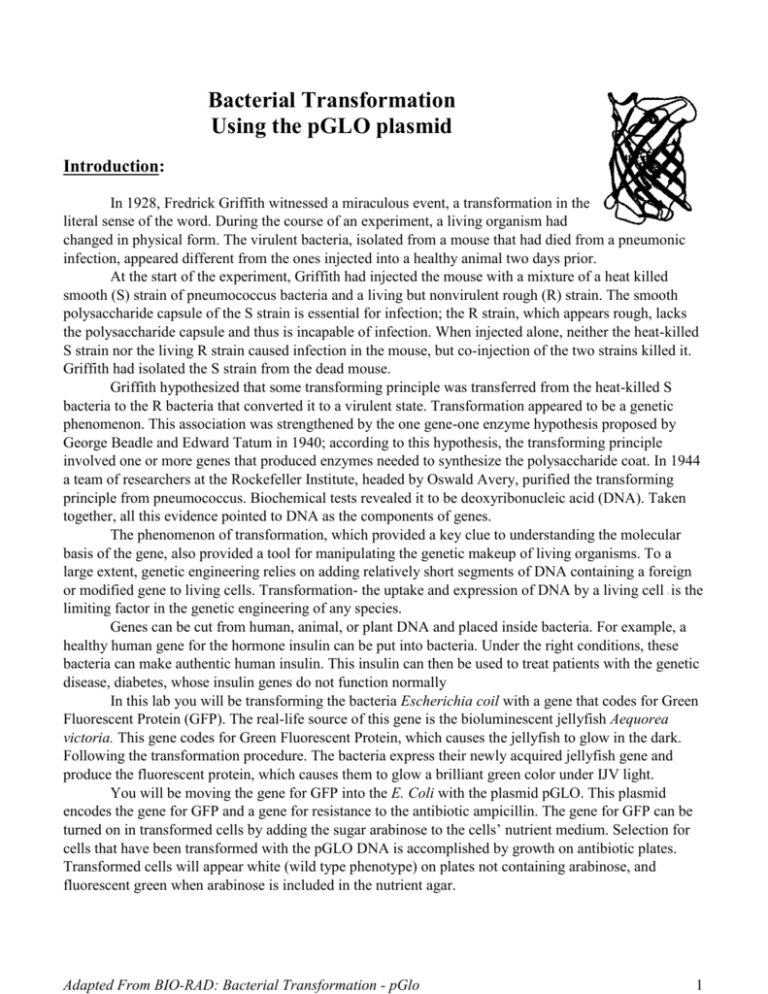
Bacterial Transformation Using the pGLO plasmid Introduction: In 1928, Fredrick Griffith witnessed a miraculous event, a transformation in the literal sense of the word. During the course of an experiment, a living organism had changed in physical form. The virulent bacteria, isolated from a mouse that had died from a pneumonic infection, appeared different from the ones injected into a healthy animal two days prior. At the start of the experiment, Griffith had injected the mouse with a mixture of a heat killed smooth (S) strain of pneumococcus bacteria and a living but nonvirulent rough (R) strain. The smooth polysaccharide capsule of the S strain is essential for infection; the R strain, which appears rough, lacks the polysaccharide capsule and thus is incapable of infection. When injected alone, neither the heat-killed S strain nor the living R strain caused infection in the mouse, but co-injection of the two strains killed it. Griffith had isolated the S strain from the dead mouse. Griffith hypothesized that some transforming principle was transferred from the heat-killed S bacteria to the R bacteria that converted it to a virulent state. Transformation appeared to be a genetic phenomenon. This association was strengthened by the one gene-one enzyme hypothesis proposed by George Beadle and Edward Tatum in 1940; according to this hypothesis, the transforming principle involved one or more genes that produced enzymes needed to synthesize the polysaccharide coat. In 1944 a team of researchers at the Rockefeller Institute, headed by Oswald Avery, purified the transforming principle from pneumococcus. Biochemical tests revealed it to be deoxyribonucleic acid (DNA). Taken together, all this evidence pointed to DNA as the components of genes. The phenomenon of transformation, which provided a key clue to understanding the molecular basis of the gene, also provided a tool for manipulating the genetic makeup of living organisms. To a large extent, genetic engineering relies on adding relatively short segments of DNA containing a foreign or modified gene to living cells. Transformation- the uptake and expression of DNA by a living cell is the limiting factor in the genetic engineering of any species. Genes can be cut from human, animal, or plant DNA and placed inside bacteria. For example, a healthy human gene for the hormone insulin can be put into bacteria. Under the right conditions, these bacteria can make authentic human insulin. This insulin can then be used to treat patients with the genetic disease, diabetes, whose insulin genes do not function normally In this lab you will be transforming the bacteria Escherichia coil with a gene that codes for Green Fluorescent Protein (GFP). The real-life source of this gene is the bioluminescent jellyfish Aequorea victoria. This gene codes for Green Fluorescent Protein, which causes the jellyfish to glow in the dark. Following the transformation procedure. The bacteria express their newly acquired jellyfish gene and produce the fluorescent protein, which causes them to glow a brilliant green color under IJV light. You will be moving the gene for GFP into the E. Coli with the plasmid pGLO. This plasmid encodes the gene for GFP and a gene for resistance to the antibiotic ampicillin. The gene for GFP can be turned on in transformed cells by adding the sugar arabinose to the cells’ nutrient medium. Selection for cells that have been transformed with the pGLO DNA is accomplished by growth on antibiotic plates. Transformed cells will appear white (wild type phenotype) on plates not containing arabinose, and fluorescent green when arabinose is included in the nutrient agar. - Adapted From BIO-RAD: Bacterial Transformation - pGlo 1 Biotechnology I GT Mrs. Walker Name: Date: Pre-Lab Questions: 1. On which plate would you expect to find non- transformed bacteria? Explain your predictions. 2. If there were any genetically transformed bacterial cells, on which plate(s) would they be most likely located? Explain your predictions. 3. Which plates should be compared to determine if genetic transformation has occurred? Why? Predicted Observations: Sketch and describe what you expect to see on each of the plates listed below. Transformed Plates +DNA LB/amp +DNA LB/amp/ara Control Plate -DNA LB/amp Adapted From BIO-RAD: Bacterial Transformation - pGlo 2 Control Plate -DNA LB 4. How could you prove that these changes that occurred were due to the procedure that you performed? 5. What factors might influence transformation efficiency? 6. Very often an organism’s traits are caused by a combination of its genes and its environment. In this case what two factors must be present in the bacteria’s environment for you to see the green color? 7. What advantage would there be for an organism to be able to turn on or off particular genes in response to certain conditions? Adapted From BIO-RAD: Bacterial Transformation - pGlo 3

